Drone Conference Examines Security And Safety Implications

Experts discuss safeguarding against drones that pose increasing threats to prisons, airports and public safety
A gathering of industry experts took place this week in London to discuss ways of the tackling the growing menace posed by the ‘drone revolution’.
According to the ‘Countering Drones conference‘ that took place on Wednesday and Thursday, the drone market is booming and is currently estimated to be worth at least $127 billion (£101bn).
But drones pose serious security implications, as the unmanned devices are increasingly being used to smuggle drugs into prisons, and are also posing a risk to civilian aircraft and major sporting events. Last year for example, a drone crash-landed into stands during a match the US Open tennis tournament.
 Drone Menace
Drone Menace
In light of these issues, the conference organisers Defence IQ set up the first of its kind drone security conference, where experts and officials gathered to discuss ways to deal with the growing problem and ensure public safety.
It comes after Defence IQ carried out a survey which found that nearly 80 percent of respondents believe a major security incident involving drones in civilian airspace was strongly likely or almost certain to happen in the next five years.
Drones are also a serious problem for prisons, where they are used to smuggle in drugs or other contraband to prisoners.
And it is not just the threat to airports and prisons that drones can pose, as the machines become increasingly affordable and high-powered. Drones can also threaten the security of public buildings, major sporting events, and even nuclear facilities.
But it has been near misses with commercial aircraft that has brought the subject front and centre into the public spotlight in recent times.
According to The Guardian, there were four serious incidents were reported in July alone, with unmanned aircraft spotted as close as five metres from passenger jets taking off or landing.
The newspaper quoted Steve Landells, safety officer at the British Airline Pilots Association, as saying that it is often unclear whether close calls are due to naive drone pilots or potentially malicious actors.
“Whether that person’s deliberately flying a drone around an airport to stop all traffic to disrupt things or because they just want some pretty pictures, the end result from an aviation point of view is roughly the same,” he said, warning that their presence dangerously distracts pilots during takeoff and landing phases.
“As a pilot you’re coming into land, you’ve got 200 tonnes of metal and human beings behind you and you’re trying to put an aircraft down on an area the size of a couple of tennis courts at 150mph. The last thing you really need to be doing is having a sudden shock … that’s the danger the drones pose,” Landells said.
Drone Countermeasures
The threats posed by drones has led firms to begin working on drone countermeasures. Last month for example, German telecoms giant Deutsche Telekom revealed it was developing a drone defence system designed to guard airports, critical infrastructure, car test tracks and stadiums.
Airbus has also partnered with Dedrone to work on long-rage sensors and jamming technologies to protect airports from public piloted drones.
Last year police in Japan created a dedicated drone takedown squad. The squad are equipped with a specialised drone that uses a net to disable nuisance drones.
The netting technique came after a drone landed on the roof of the Japanese prime minister’s office. It was carrying a small amount of radioactive material, and although no one was hurt, a man was later arrested over the matter.
Meanwhile in Holland, Dutch police are training eagles to take out airborne vehicles that could pose a threat to public safety. The birds are able to attack the drones without hurting themselves due to their strong claws and talons.
![]() The University of Birmingham has previously highlighted the security risks of drones, especially as the aircraft could be possibly used by terror groups to attack public events.
The University of Birmingham has previously highlighted the security risks of drones, especially as the aircraft could be possibly used by terror groups to attack public events.
Pop star Enrique Iglesias was left bloodied and bruised following a run-in with a drone in front of a crowd of 12,000 fans at a concert in Tijuana, Mexico as part of his ‘Sex and Love’ world tour.